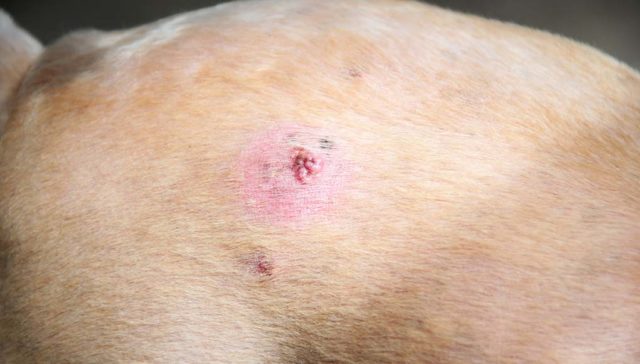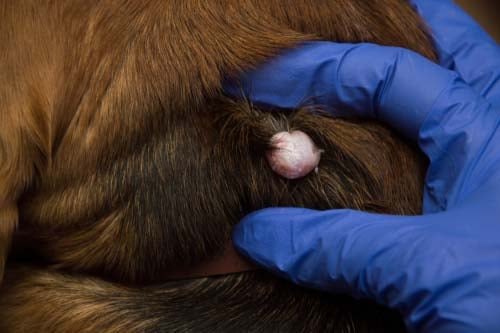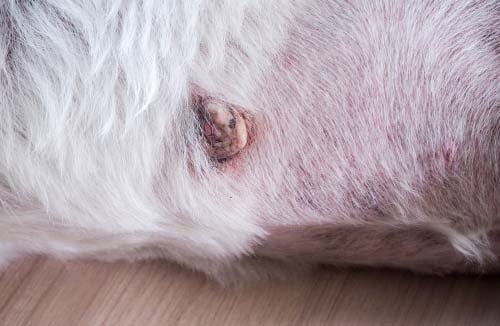
You’re carelessly petting your dog and suddenly you notice a lump on their back.
Your heart starts racing and you question yourself whether the lump was there earlier or if it has recently appeared.
Either way, do not panic.
While many people immediately think about the worst possible scenarios, the likeliest diagnosis is fatty tumors, which are benign and thus not dangerous for your pooch.
If you are not sure about the cause of the lump, schedule an exam with a vet, especially if you notice that your pooch is in pain.
Diagnosing the Cause of Bumps on a Dog's Back
The vet is going to examine your pet and try to find the cause of the growth on his back.
They might also ask you some questions that would help to narrow down the list of possible conditions.
For example, whether the lump appeared suddenly or whether it has been there for a while.
If you have noticed the lump on your dog's back earlier, the vet may ask you did it change its shape or color.
And most importantly, if it has any effect on your pet's behavior (loss of appetite, lethargy, etc.).
The vet will finally confirm the cause of the lump and prescribe the plan of treatment best suitable for your pup's condition.
They may take a sample of cells from the affected area in case the eye test is inconclusive.
The treatment may greatly vary depending on the cause so it is very important to include all the factors.
Here are some possible causes for bumps on a dog's back and what to do.
1. Fleas
One of the most common causes of tiny bumps on a dog’s back is these little parasites. You will probably miss the insects themselves but their droppings of eggs should be visible.
The first sign of these pests is your pet's non-stop scratching. They can be very dangerous if left untreated because they can cause infections that leave your dog vulnerable to other intruders.
To prevent them from attacking your dog, there are a number of tools and methods you can use. Try either a flea collar, flea drops, or any other flea treatments; keep your pooch's surrounding as clean as possible. If your dog is already affected, the vet will likely prescribe topical and/or oral flea killers.
2. Ticks
They can most often be found in tall grass, especially in spring and summer. It is usually easy to spot them, particularly if your dog has short hair. You should carefully and methodically remove ticks from your dog with a pair of tweezers – gently pull them straight out. It is very important to do it slowly because a part of the tick may remain in your dog and cause infections and further complications.
If you are not sure how to do it properly on your own, leave it to the professionals and take your dog to the vet or groomer so they can do it for you. To prevent the problem in the first place, do not walk your dog through the tall grass and invest in tick collars.
3. Mange
The mange skin disorder is caused by parasites called mites. These parasites are tiny and burrow under your dog’s skin where they can cause irritation and inflammation. There are two kinds of mange that affect dogs:
- Sarcoptic mange, which can easily spread among dogs and people, although these mites are not able to survive on people. The most common symptoms of sarcoptic mange include sores, red skin, and hair loss.
- Demodectic mange is not contagious like sarcoptic mange. It can cause bald spots and sores on your dog’s skin.
Treatment of mange in dogs and getting rid of these parasites can often be tricky because of their reproduction cycles. Possible solutions are chemical-based injections, anti-parasitic meds, and topical pesticides.
4. Ringworm
Although the name would suggest otherwise, this disorder is caused by fungus and not parasites like other types of worms that attack dogs. Its name comes from circular lesions that can appear anywhere on the dog’s body. These lesions are often surrounded by inflammation and hair loss.
Ringworm disease can spread from one dog to another in no time since it is highly contagious. However, the infection is superficial and usually only affects a few areas of your pup's body.
Your best bet against ringworm is to keep your pooch away from infected animals. However, that is not always possible and if your dog contracts ringworm, there are various anti-fungal creams and oral medications that can help him.
5. Warts
Any dog can get warts, although younger animals and dogs spending a lot of time around other dogs are more susceptible. Warts can appear anywhere on the dog’s body, and their appearance is most often described as a cauliflower. The less common type is an inverted papilloma, which appears as a firm lump with a dot in the middle.
Warts are caused by the papillomavirus. It is contagious to other dogs, but not to other animals and humans. Warts usually disappear on their own but in case they start bleeding or the dog’s immune response is too weak, they may require a vet’s assistance.
The most common treatments are oral medications that stimulate the immune system and topical anti-tumor medications. If you notice your dog has developed warts, try to keep him away from other dogs until they disappear.
6. Sebaceous Cysts
They appear when a hair follicle or skin pore gets clogged with dirt or blocked by scar tissue and then becomes inflamed. An oily substance called sebum which is responsible for your dog’s shiny hair can also clog the pores and cause this inconvenience.
You can easily recognize these cysts as bluish bumps on your dog’s skin. If they burst, they will ooze a grayish-white or brownish discharge. These cysts are basically very large pimples that are usually harmless to your pet.
As for the treatment, anti-inflammatory drugs and antibiotics usually do the trick. It is better to check with your vet though, because they may be mistaken for something more serious. The easiest way to prevent them from appearing in the first place is proper skin and hair hygiene for your dog.
7. Skin Tumors
Hard lumps require a bit more urgency since they can be skin tumors. In fact, skin tumors are the most commonly diagnosed tumors in dogs because they are more visible than others.
If you notice one of these, you should notify your vet immediately. They can be benign but could also develop into a cancerous tumor. There is no way to be sure until a biopsy is performed.
If the tumors are benign and have not spread, they can simply be removed. However, if the skin tumor is cancerous then the further treatment will depend on many factors, especially the size of the tumor and how much it has spread. Usually, treatment will include surgery, radiation therapy or chemotherapy, or some combination of these treatments.
Bumps on a Dog's Back: BeforeYou Go…
The most important thing is not to panic when you find a growth on your dog's back. The majority of these diseases are not dangerous if treated on time. That is why you should bring your pooch to the vet as soon as possible and discuss a further plan of action.
In the meantime, try to keep your dog’s hygiene at the highest possible level, because most of these diseases could be avoided if you keep your dog and its living area clean.
READ NEXT: My Dog Has Bumps Under Her Fur – 5 Things This Could Be



















